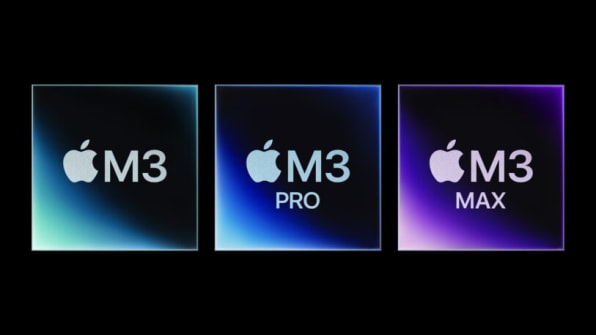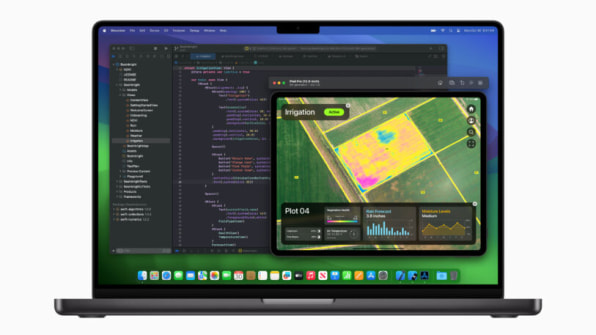Thanks as always for reading Plugged In, Fast Company’s weekly tech update. If a friend or colleague forwarded this edition to you—or you’re reading it on FastCompany.com—you can check out previous issues and sign up to get it yourself every Wednesday morning. I’m always pleased to hear from you: Send me your feedback and ideas at hmccracken@fastcompany.com.
Let’s kick things off with links to a few Fast Company tech stories you might not have seen yet:
- Is Biden doing enough to protect workers from AI?
- How Beatles producer Giles Martin used AI to reunite the band for ‘Now and Then’
- Elon Musk’s selling point for ChatGPT competitor Grok may be its fatal flaw, experts say
- How Bumble’s incoming CEO Lidiane Jones plans to use AI to take matching to the next level
When the MacBook Air and MacBook Pro were young, nobody who was paying attention could have confused them.
After all, the original MacBook Air, introduced by Steve Jobs at Macworld Expo in January 2008, achieved its then-remarkable svelte profile and three-pound weight by stripping out as many features as possible, until it could just barely accommodate a single USB port. Later that year, Apple introduced a MacBook Pro that weighed well over twice as much as the Air—but that sported a truly humongous 17-inch screen, three USB ports, and numerous accoutrements that mattered to plenty of people at the time, including a DVD burner, Ethernet, and FireWire. The Pro was also way, way faster than the notoriously underpowered Air.
More than 15 years and too many upgrades to count later, the MacBooks Air and Pro are still with us. But along the way, Apple kept making the Air nicer and more capable. At the same time, it made the Pro more and more portable, shedding elements that had once distinguished it from the Air. Eventually, the two types of MacBooks felt more like variations on the same theme than radically different machines. At times, that could be confusing (if you couldn’t tell which model you needed) or even aggravating (if you didn’t consider the MacBook Pro to be pro enough).
I’ve been thinking about that trajectory over the past few days, while trying out a new MacBook Pro provided by Apple for review. Announced last week at the company’s “Scary Fast” pre-Halloween streamed keynote, the 14-inch model I’ve been using is part of an updated MacBook Pro lineup that’s notable for introducing three chips: the M3, M3 Pro, and M3 Max. They represent the second wave of processor upgrades that Apple has given the MacBook Pro since January, a rate of progress that’s a boon to users engaged in work—such as 3D modeling or advanced media production—that demands as much speed as possible.
Otherwise, the new MacBook Pros, like January’s models, add more computational muscle to the same basic recipe as the first Pros powered by Apple silicon, which came out in 2021. Last week, Apple implicitly acknowledged their evolutionary nature by spending most of its keynote pitching them to folks who have clung to aging MacBook Pros based on Intel processors, who should find the new Pros to be colossal advances.
The fact that Apple didn’t mess with most of the features that define the MacBook Pro doesn’t feel like a missed opportunity. The company has finally gotten to a place where the Pro and Air lines—for all their similarities—are also distinct enough that they serve different needs. By getting bragging rights to the very latest Apple silicon, the new MacBook Pros simply keep a good thing going.

True, the cheapest new MacBook Pro—a 14-inch version with the baseline M3 chip—starts at $1,599, which puts it in the same zip code as some MacBook Air configurations. Along with the new processor, that laptop does have some features that a critical mass of serious users care about, from fancier screen technologies (MiniLED backlighting, ProMotion) to an SD slot for digital camera memory cards.
But the MacBook Pro line comes into its own once you spring for configurations that take it well beyond the Air’s specs and price points. The $4,299 version I’ve been trying has the top-of-the-line M3 Max chip and 64 GB of RAM (three times the Air’s maximum and by far the most in any personal computer I’ve ever used). I didn’t run test benchmarks to compare the M3 Ultra-equipped MacBook Pro to a MacBook Air with an M2 chip. However, ZDNet’s Jason Hiner, who reviewed the same $4,299 Pro that I have, did—and found that the Pro thrashed the Air.
The comparison matters to me: I bought a 15-inch MacBook Air four months ago. That recent purchase meant I came to the new MacBook Pro a tad concerned I’d feel some combination of buyer’s remorse and envy for those whose computer budgets are more lavish than my own. Indeed, the Pro’s snappier performance was sometimes apparent to me, and its fancier display was obvious. Using it, I was reminded how much I like having USB-C access on both sides of a laptop—the Air’s two ports are both on the left—and that its built-in HDMI and SD capability would greatly reduce the need for those dreaded, easily-lost dongles.
One other point in the MacBook Pro’s favor: Apple says the “Space Black” finish on the unit I’ve been using was anodized with a new technology that makes it more resistant to fingerprints than my MacBook Air’s “Midnight.” It did seem to help the Pro’s case remain in something closer to pristine condition, though both finishes look more like deep grays to me than their names suggest. (If the company ever makes a vantablack MacBook, I’ll be first in line to preorder one.)

In the end, I was relieved to discover that spending time with the new MacBook Pro didn’t ruin my appreciation for my much cheaper, almost-new 15-inch MacBook Air. The two laptops offer many of the same benefits, from a terrific keyboard and trackpad to the ability to charge via either MagSafe or USB-C. I’ve grown fond of the Air’s roomier display, which carries no weight tax compared to the 14-inch Pro. (Actually, the Air is slightly lighter.) Apple even rates the Air as having better “wireless web” battery life: 15 hours versus the 14-inch Pro’s 12 hours—though both those figures remain astonishingly good compared to the Intel Macs of yore.
That the MacBook Air stands up so well isn’t evidence that the MacBook Pro’s more advanced features are gilding the technological lily. It’s more that the mix of Pro and Air similarities and differences have settled into a happy equilibrium where both types of MacBooks do everything a modern Mac should. And yet each caters to its own clear constituency, with the Air skewing in the direction of affordability and the Pro toward advanced technology. Maybe Apple should have mastered that balance all along, but it’s sometimes fallen out of whack, proving how tough that is to maintain.
Which does leave one question: What’s next? The MacBook Pro is still benefiting from Apple’s willingness in 2021 to restore the built-in HDMI and SD slot it had previously taken away. I’m pretty sure the next big thing that keeps the Pro feeling professional won’t involve further restoration of venerable technologies. But something will need to distinguish future Pros from Airs.
That’s assuming there will be a MacBook Pro forever: Last year, The Verge’s Mitchell Clark ruminated on the intriguing possibility that Apple might shift from “Pro” to “Studio” as the brand signifying the best stuff for its most demanding, deep-pocketed customers. Maybe it will, maybe it won’t. But one way or another, I hope its portable line remains as coherent as it is right now.
Connectez-vous pour ajouter un commentaire
Autres messages de ce groupe

From family photos in the cloud to email archives and social media accounts, the digital lives of Americans are extensive and growing.
According to recent studies by the password managem

A dozen years after its launch, fintech company Chime rang the bell this morning at the Nasdaq MarketSite in Times Square to ce

It hits at a certain time in the afternoon, when a familiar craving strikes. You walk to the kitchen. The satisfying sound of a can cracking, the hiss of bubbles. It’s time for a “fridge cigarette

Many developers find that AI programming assistants have made writing code easier than ever. But maintaining the infrastructure that actually runs that code remains a challenge, requiring engineer


Fraudulent job applications have become a serious issue in the era of

With the first family actively engaged in memecoin ventures, speculation about the future of cryptocurrency has never been hotter. Laura Shin, crypto expert and host of the podcast Unchained
